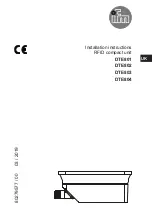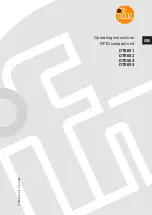
9440300990 Rev J
13
DECS-250
Voltage and Current Sensing
Voltage and Current Sensing
The DECS-250 senses generator voltage, generator current, and bus voltage through dedicated, isolated
inputs.
Generator Voltage
Three-phase generator sensing voltage is applied to DECS-250 terminals E1, E2, and E3. This sensing
voltage is typically applied through a user-supplied voltage transformer, but may be applied directly.
These terminals accept three-phase, three-wire connections at terminals E1 (A), E2 (B), and E3 (C) or
single-phase connections at E1 (A) and E3 (C).
The generator voltage sensing input accepts a maximum voltage of 600 Vac and has a burden of less
than 1 VA.
The transformer primary and secondary winding voltages are entered in settings that the DECS-250 uses
to interpret the applied sensing voltage and calculate system parameters. The phase rotation of the
generator sensing voltage can be configured as ABC or ACB. Information about configuring the DECS-
250 for the generator sensing voltage is provided in the
Configuration
chapter of this manual.
Typical generator voltage sensing connections are illustrated in Figure 5.
Figure 5. Typical Generator Voltage Sensing Connections
Generator Current
Generator current sensing inputs consist of three phase-sensing inputs and a sensing input for cross-
current compensation.
Note
Current transformer (CT) grounding should be applied in accordance
with local codes and conventions.
Phase Sensing
Three-phase generator sensing current is applied to DECS-250 terminals CTA+ and CTA–, CTB+ and
CTB–, and CTC+ and CTC– through user-supplied current transformers (CTs). Single-phase generator
sensing current is applied to DECS-250 terminals CTB+ and CTB–. The DECS-250 is compatible with
CTs having 5 Aac or 1 Aac nominal secondary ratings. The DECS-250 uses this secondary rating, along
with the CT nominal primary ratings to interpret the sensed current and calculate system parameters.
Information about configuring the DECS-250 for the generator sensing voltage is provided in the
Summary of Contents for DECS-250
Page 2: ......
Page 6: ...iv 9440300990 Rev J Revision History DECS 250 ...
Page 16: ...xiv 9440300990 Rev J Contents DECS 250 ...
Page 20: ...4 9440300990 Rev J Introduction DECS 250 ...
Page 28: ...12 9440300990 Rev J Power Stage DECS 250 ...
Page 32: ...16 9440300990 Rev J Voltage and Current Sensing DECS 250 ...
Page 40: ...24 9440300990 Rev J Synchronizer DECS 250 ...
Page 52: ...36 9440300990 Rev J Auxiliary Control DECS 250 ...
Page 56: ...40 9440300990 Rev J Contact Inputs and Outputs DECS 250 ...
Page 84: ...68 9440300990 Rev J Limiters DECS 250 ...
Page 114: ...98 9440300990 Rev J Power System Stabilizer DECS 250 Figure 96 PSS Parameter Settings ...
Page 124: ...108 9440300990 Rev J Stability Tuning DECS 250 ...
Page 126: ...110 9440300990 Rev J Mounting DECS 250 Figure 103 Overall and Projection Mounting Dimensions ...
Page 127: ...9440300990 Rev J 111 DECS 250 Mounting Figure 104 DECS 250 Escutcheon Plate Dimensions ...
Page 198: ...182 9440300990 Rev J Timekeeping DECS 250 ...
Page 210: ...194 9440300990 Rev J CAN Communication DECS 250 ...
Page 304: ...288 9440300990 Rev J Maintenance DECS 250 ...
Page 316: ...300 9440300990 Rev J Specifications DECS 250 ...
Page 334: ...318 9440300990 Rev J Analog Expansion Module DECS 250 ...
Page 351: ......
















































